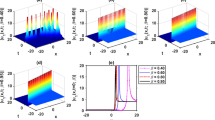Abstract
The staggered-grid finite-difference method (SGFDM) has been extensively employed in numerical modeling, seismic imaging, and waveform inversion because of its high efficiency, accuracy, and practicality. Numerical modeling accuracy is crucial for imaging and inversion. Truncating the spatial convolution sequence of the pseudospectral method by window functions can derive the finite-difference method. However, truncation error is inevitable; it can create illusions in numerical modeling, leading to misjudgments. To reduce the truncation error and improve numerical modeling accuracy, enhancing the performance of the truncated window function is imperative. In this study, a new optimal window function was investigated based on the least-squares combination of square windows. Then, the new optimized window function was used to truncate the spatial convolution sequence of the pseudospectral method and obtain an optimized SGFDM. Dispersion analysis showed that the optimized SGFDM has wider spectrum coverage than the conventional SGFDM at the same order. In addition, at low orders, the error range of the new optimized SGFDM could be strictly controlled within 1‱, whereas, at high orders, while ensuring accuracy, the spectrum coverage significantly improved. Finally, numerical modeling for elastic waves demonstrated that the optimized SGFDM could superiorly suppress numerical dispersion and improve calculation efficiency.
Similar content being viewed by others
References
Bansal, R., Sen, M. K., 2008, Finite-difference modelling of S-wave splitting in anisotropic media[J]. Geophysical Prospecting, 56(3): 293–312.
Chu, C. L., Stoffa, P. L. 2012, Determination of finite-difference weights using scaled binomial windows: Geophysics, 77, W17–W26.
Duan, P., Li Q. Y., Zhao, Z., et al., 2019, High-order finite-difference method based on equivalent staggered grid scheme for scalar wavefield simulation. Progress in Geophysics (in Chinese), 34(3): 1032–1040.
Fornberg, B., 1987, The pseudo-spectral method: Comparisons with finite-differences for the elastic wave equation: Geophysics, 52, 483–501.
He, Z., Zhang, J., Yao, Z., 2019, Determining the optimal coefficients of the finite difference method using the Remez exchange algorithm[J]. Geophysics, 1–47.
Hicks, Graham, J., 2012, Arbitrary source and receiver positioning in finite-difference schemes using Kaiser windowed sinc functions[J]. Geophysics, 67(1):156–165.
Igel, H., Mora, P., Riollet, B., 1995, Anisotropic wave propagation through finite-difference grids[J]. Geophysics, 60(4):1203–1216.
Levander, A. R., 1988, Fourth-order finite-difference P-SV seismograms[J]. Geophysics, 53(11):1425–1436.
Li, S. Z., Sun, C. Y., Peng, P. P., 2018, Seismic wave field forward modeling of variable staggered grid optimized difference coefficient method [J]. Geophysical Prospecting for Petroleum, 57(3):378–388.
Liang, W., Wang, Y., Yang, C., 2017, Acoustic wave equation modeling with rectangle grid finite difference operator and its linear time space domain solution[J]. Shiyou Diqiu Wuli Kantan/Oil Geophysical Prospecting, 52(1):56–62.
Liu, H., Wang, Z., 2015, Optimized staggered-grid finite-difference operators based on combined window[J]. Near-Surface Asia Pacific Conference, Waikoloa, Hawaii, 83–87.
Liu, Y., Sen, M. K., 2009, A new time-space domain high-order finite-difference method for the acoustic wave equation[J]. Journal of Computational Physics, 228(23):8779–8806.
Liu, Y., Sen, M. K., 2010, Finite-difference modeling with adaptive variable-length spatial operators[J]. Geophysics, 76(4):2930.
Liu, Y., Sen, M. K., 2011, 3D acoustic wave modelling with time-space domain dispersion-relation-based finite-difference schemes and hybrid absorbing boundary conditions[J]. Exploration Geophysics, 42(3):176.
Madariaga, R., 1976, Dynamics of an expanding circular fault [J]. Bull.seism.soc.am, 66(3):639–666.
Paulo, D., Sergio N., Eduardo, D. S., 2002, Digital signal processing: system analysis and design[M]. Cambridge University Press.
Peng Y., Jian-Ping, H., Zhen-Chun, L., et al., 2016, Optimized staggered-grid finite-difference method in time-space domain based on exact time evolution schemes[J]. Chinese Journal of Geophysics, 59(11).
Ren, Y. J., Huang, J. P., Yong, P., et al., 2018, Optimized staggered-grid finite-difference operators using window functions[J]. Applied Geophysics, 15(2):253–260.
Tian X. F., 2019, Higher order time difference scheme and stability analysis for first-order elastic wave staggered grid. Geophysical Prospecting Research Institute, 31(05): 70–78.
Virieux, J., 1984, SH-wave propagation in heterogeneous media: Velocity stress finite-difference method: Geophysics, 49, 1933–1942.
Virieux, J., 1986, P-SV wave propagation in heterogeneous media; velocity-stress finite-difference method[J]. Geophysics, 51(11):1933–1942.
Wang, J., Meng, X. H., Liu, H., et al., 2017, Cosine-modulated window function-based staggered-grid finite-difference forward modeling[J]. Applied Geophysics, 14(1):115–124.
Wang, Y., Liu, H., Zhang, H., et al., 2016, A global optimized implicit staggered-grid finite-difference scheme for elastic wave modeling. Chinese Journal of Geophysics, 58(7): 2508–2524.
Wang, Z. Y., Liu, H., Tang, X. D., et al., 2015, Optimized finite-difference operator based on chebyshev auto-convolution combined window function. Chinese Journal of Geophysics, 58(2):192–206.
Yan, H., Yang, L., Li, X.Y., 2016, Optimal staggered-grid finite-difference schemes by combining Taylor-series expansion and sampling approximation for wave equation modeling [J]. Journal of Computational Physics, 326: 913–930.
Yang, L., Yan, H., Liu, H., 2017, Optimal staggered-grid finite-difference schemes based on the minimax approximation method with the Remez algorithm[J]. GEOPHYSICS, 82(1): T27–T42.
Zheng, W. Q., Meng, X. H., Liu, J.H., et al., 2016, High precision elastic wave equation forward modeling based on cosine modulated Chebyshev window function. Chinese J. Geophys (in Chinese), 59(7):2650–2662.
Zhou, B., Greenhalgh, S. A., 1992, Seismic scalar wave equation modeling by a convolutional differentiator. Bulletin of the Seismological Society of America, 82(1):289–303.
Author information
Authors and Affiliations
Corresponding author
Additional information
This work was supported by the Joint Funds of the National Natural Science Foundation of China (grant number U20B2014), the State Key Program of National Natural Science Foundation of China (grant number 41630319), and the National Science and Technology Major Project of China (grant number 2016ZX05024-001-001).
Chen Chao-pu, a postgraduate student at Beijing University of Chemical Technology, specializes in High-Speed Rail Seismology, Asymmetric Elastic Wave Equations, modelling and imaging of complex structures.
Rights and permissions
About this article
Cite this article
Chen, Cp., Liu, H., Wang, Zy. et al. Optimizing staggered-grid finite-difference method based on the least-squares combination of the square window function. Appl. Geophys. (2021). https://doi.org/10.1007/s11770-021-0884-4
Received:
Revised:
Published:
DOI: https://doi.org/10.1007/s11770-021-0884-4




